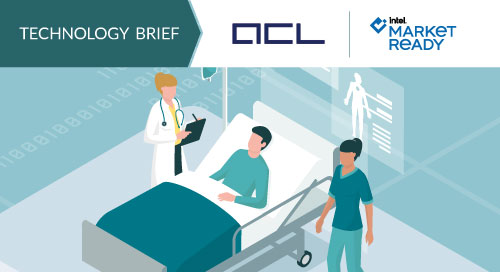Fill form to unlock content
Error - something went wrong!
Stay up to date with the latest IoT and network edge news.
Subscribed.
Medical-Grade PCs: Foundation for Digital Transformation

Picture a patient admitted to the hospital with chest pains being automatically reminded to follow up with a cardiologist six months later. Or the healthcare consumer being able to access all their medical records from different facilities through one portal.
Such patient-centered convenience is the result of improved workflows and processes, the result of seamless data collection and analysis at all points of the patient’s healthcare journey. Reliable and easily analyzed data delivers better experiences for patients and caregivers, improved health outcomes, and cost efficiencies.
Data is the cornerstone of digital transformation, which “is both the greatest opportunity and the greatest challenge currently facing the healthcare system worldwide,” says Maik Kränkel, Senior Vice President for Business Development at ACL, a German provider of medical-grade computers and IT solutions. Companies like ACL develop and produce hardware solutions that address the unique needs of the healthcare sector.
Challenges of Digital Transformation in Healthcare
While digital transformation is indeed revolutionary, its execution runs into a few challenges in the healthcare sector. For one thing, to ensure patient-focused care, medical facilities need to aggregate information from various patient touchpoints—registration, appointment booking, lab tests, and more—into one platform for analysis.
But the various software programs that hospitals use to gather patient data are not always compatible. In such cases, patient data retrieval might become a challenge.
In addition, medical facilities frequently lack compatible infrastructure in the front end and back end that can accommodate seamless data flow and analysis from the edge to the cloud and back. Andreas Ertel, Senior Principal Engineer, OEM & IoT Solutions at Dell Technologies, has observed that when hospitals want to launch a digital initiative that includes edge computing devices, they understandably want it to integrate with existing infrastructure. “They want to have consistent platforms for frictionless deployment and seamless integration into an existing system management,” Ertel says.
Smart Health Computing
As digital transformation rapidly becomes a must-have in healthcare, these edge computing devices, the medical-grade computers used for gathering or delivering patient data, are increasingly under the microscope. While most industries would simply use a standard PC (rugged or otherwise) at the edge, you can’t take such standard business devices for granted in healthcare.
“Medical-grade all-in-one PCs are significantly different from standard PCs,” Kränkel says. A medical computer must comply with safety and effectiveness requirements like the IEC 60601-1 for medical electrical equipment. And while hygiene has always been a priority at healthcare facilities, the COVID-19 pandemic has amplified these concerns. “To address hygiene issues, medical-grade PCs can’t have edges, openings, or active fans in the housing where dirt can creep in,” Kränkel adds. “You must make it easy to disinfect.”
Such a medical-grade all-in-one PC equipped with ULV (ultra-low-voltage) processor also necessitates effective temperature 24/7 management of the passive cooling systems because standard cooling with fans would spread germs around. In contrast to medical PCs with plastic housings, medical PCs with all-aluminum housings act as passive heat sinks with excellent thermal conductivity, which enables a long service life of the electronic components.
“Usability and resiliency are most important to nurses, and that applies not only to #software applications, but also #hardware requirements” – Maik Kränkel, ACL GmbH via @insightdottech
“Usability and resiliency are most important to nurses,” Kränkel says, “and that applies not only to software applications but also hardware requirements.” Nurses look for hardware with fewer cables that can get entangled in patients’ beds and cleaning mode functionality so you can deactivate the touchscreen to disinfect the computer while it’s still running. A night mode enables switching off the TFT back light at night for greater patient comfort.
In addition, a healthcare edge device needs to be secure and resilient against data breaches and other vulnerabilities. To that end, RFID readers that enable selective data access only to qualified professionals are an important part of medical-grade computers.
Dell-ACL Partnership
To meet these stringent requirements and deliver comprehensive digital transformation solutions, ACL and Dell Technologies have developed a partnership that capitalizes on their strengths. “ACL is very well known in the medical market and understands mandatory regulatory certifications, and at Dell, we have a strong footprint in hospitals from an IT back-end perspective,” Ertel points out.
ACL complements its expertise in developing custom medical-grade IT solutions and delivers PCs that will seamlessly integrate with the Dell platform. The OR-PC series from ACL, for example, does its job 24/7 with fanless cooling in areas where hygiene is the highest priority. ACL hardware uses Intel processors and WiFi chipsets, Kränkel says.
The ACL-Dell partnership pressed into service when a hospital group in Germany, which was using Dell Technologies for its IT infrastructure, wanted to also use Dell for medical-grade edge computing devices. ACL integrated the mechanical and electronic aspects of the Dell hardware platform into edge medical devices.
“In environments like medical facilities, we need technology partners like ACL that don’t create silos,” Ertel says. “With these medical grade OR-PCs, we have developed a blueprint for how we approach these situations.” The mutually beneficial partnership also helps customers achieve digital transformation across all data points. “It’s a triple-win situation,” Ertel says.
The Future of Healthcare Devices
Expect medical-grade PCs to evolve along with healthcare delivery, Kränkel says.
Already, telemedicine is spurring demand for telehealth equipment with larger screens and better wireless connectivity. In operating theaters, the functionalities of video management solutions also require high-definition screens, Kränkel points out. Mobility and portability will be key as ambulances get outfitted with more cutting-edge medical devices.
No matter where the field goes, ACL is ready, Kränkel says. At all times, “we’re 100% focused on medical-grade IT.”
Edited by Georganne Benesch, Associate Editorial Director for insight.tech.